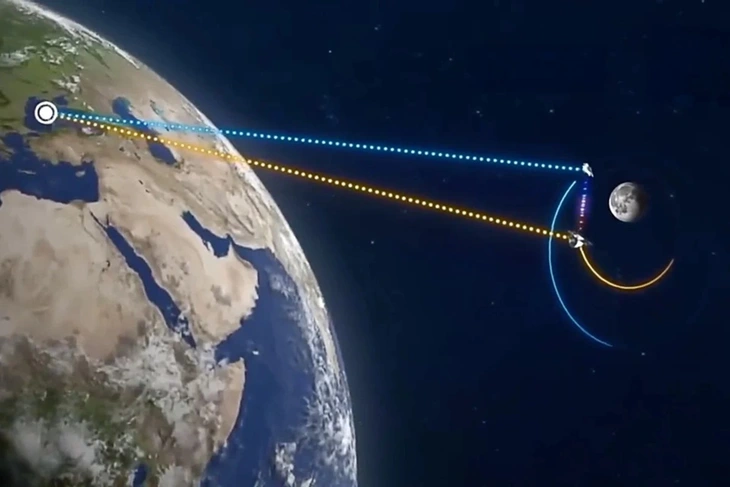
China's Tiandu-1 satellite participates in an experiment measuring the distance using laser beams in space between the Earth and the Moon during the day - Photo: CCTV
Using a new infrared laser, Chinese scientists have found that the Tiandu-1 satellite is 130,000km from Earth - a location farther than most other satellites in space. In fact, Tiandu-1 and its twin Tiandu-2 are orbiting the Moon, and are being used by China in lunar communication and navigation experiments.
According to IFLScience on May 5, this laser beam was sent from an observation station on Earth, reflected off a retroreflector on Thien Do-1 and returned to Earth in less than a second.
The Chinese team observed the laser beam using a 1.2-meter telescope at the Yunnan Observatory of the Chinese Academy of Sciences. The Chinese Academy of Sciences compared the achievement to hitting a hair from a distance of 10 kilometers.
Lasers in space have many different uses, which is why Chinese scientists are excited to be able to test the technology at such a long distance, and especially to be able to use it during the day.
Previously, the US National Aeronautics and Space Administration (NASA) used a retroreflector the size of an Oreo to search for two spacecraft on the lunar surface: India's Vikram lander and Japan's Smart Lunar Inquiry (SLIM) lander.
The laser was fired from NASA's Lunar Reconnaissance Orbiter (LRO), which used a laser altimeter (a device for mapping the Moon) to find the two landers.
"LRO's altimeter was not designed for this type of application, so the chances of accurately identifying a very small retroreflector on the lunar surface are very low," said Xiaoli Sun.
Mr. Sun leads the SLIM retroreflector team at NASA's Goddard Space Flight Center as part of a partnership between NASA and the Japan Aerospace Exploration Agency (JAXA).
LRO demonstrated its ability to laser track the Moon, but it was only 100km away from the aforementioned landers. Meanwhile, the specialized tracking system that Chinese scientists used on Tiandu-1 is a completely new approach, showing that this can be done at a distance of 1,000 times further.
In the future, lasers will play an important role in long-distance communications and may one day enable high-speed communications to Mars.
The communication technology, also known as deep space optical communication (DSOC), has been installed on NASA's Psyche spacecraft and successfully tested over a distance of hundreds of millions of kilometers, providing data transmission speeds 100 times higher than conventional radio waves.
There are limitations, however. One of them is daylight. So Chinese scientists are excited about a system that can handle the effects of sunlight like the one at the Yunnan Observatory.
Source: https://tuoitre.vn/trung-quoc-san-ve-tinh-cach-trai-dat-130-000km-bang-tia-laser-hong-ngoai-moi-20250506095525138.htm




































































































Comment (0)